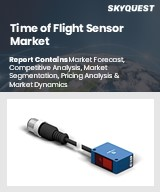
세계의 비행 시간 센서 시장 규모는 2023년에 55억 달러로 평가되며, 2024년 63억 3,000만 달러에서 2032년에는 193억 5,000만 달러로 성장하며, 예측 기간(2025-2032년)의 CAGR은 15%로 성장할 전망입니다.
세계의 비행시간(ToF) 센서 시장은 급속한 기술 발전, 자동화에 대한 정부 투자 증가, 첨단 심도 센싱 기술에 대한 소비자의 선호도 변화로 인해 강력한 성장세를 보이고 있습니다. 각국 정부는 스마트 제조, 디지털 전환, 산업 자동화, 스마트 시티 구상 등 다양한 분야에 걸쳐 3D 센싱 솔루션을 통합하는 데 주력하고 있습니다. ToF 센서가 머신러닝 및 엣지 컴퓨팅과 융합하여 공간 데이터 수집을 강화하고 컨텍스트를 고려한 활용을 가능하게 함으로써 큰 기술 혁신이 일어나고 있습니다. 에너지 효율이 높은 소형 ToF 모듈의 추세는 휴대용 장치의 전력 소비를 줄임으로써 지속가능성 목표를 지원합니다. 또한 AI의 통합으로 ToF 센서의 기능이 강화되어 교통, 보안 등의 분야에서 실시간 적응 및 지능형 데이터 처리가 가능해집니다.
Global Time of Flight Sensor Market size was valued at USD 5.50 Billion in 2023 and is poised to grow from USD 6.33 Billion in 2024 to USD 19.35 Billion by 2032, growing at a CAGR of 15% in the forecast period (2025-2032).
The global market for time of flight (ToF) sensors is experiencing robust growth due to rapid technological advancements, increased government investments in automation, and evolving consumer preferences for advanced depth-sensing technologies. Governments are focusing on smart manufacturing, digital transformation, and the integration of 3D sensing solutions across various sectors, including industrial automation and smart city initiatives. Significant technological innovations are occurring as ToF sensors converge with machine learning and edge computing, enhancing spatial data acquisition and enabling context-aware applications. The trend toward energy-efficient and compact ToF modules supports sustainability goals by reducing power consumption in portable devices. Additionally, the integration of AI enhances ToF sensor functionality, allowing for real-time adaptation and intelligent data processing across sectors like transportation and security.
Top-down and bottom-up approaches were used to estimate and validate the size of the Global Time of Flight Sensor market and to estimate the size of various other dependent submarkets. The research methodology used to estimate the market size includes the following details: The key players in the market were identified through secondary research, and their market shares in the respective regions were determined through primary and secondary research. This entire procedure includes the study of the annual and financial reports of the top market players and extensive interviews for key insights from industry leaders such as CEOs, VPs, directors, and marketing executives. All percentage shares split, and breakdowns were determined using secondary sources and verified through Primary sources. All possible parameters that affect the markets covered in this research study have been accounted for, viewed in extensive detail, verified through primary research, and analyzed to get the final quantitative and qualitative data.
Global Time of Flight Sensor Market Segments Analysis
The global time-of-flight sensor market is segmented based on product type, application, organization size, end user, and region. By product type, the market is classified into range-gated sensors, light detection and ranging (LiDAR) sensors, and 3D ToF cameras. Depending on organization size, it is divided into large and medium enterprises and small enterprises. According to the application, the market is divided into gesture recognition, distance measurement, 3D imaging, and object detection. As per end user, it is categorized into consumer electronics, automotive, industrial, healthcare, aerospace & defense, and robotics. Regionally, the market is analyzed across North America, Europe, Asia-Pacific, Latin America, and the Middle East and Africa.
Driver of the Global Time of Flight Sensor Market
One of the key market drivers for the global Time of Flight (ToF) sensor market is the rising demand for advanced imaging and sensing technologies across various applications, including consumer electronics, automotive, and healthcare. The proliferation of smartphones and smart devices, which increasingly incorporate ToF sensors for functionalities such as facial recognition, augmented reality, and depth sensing, significantly boosts market growth. Additionally, the automotive sector is leveraging ToF sensors for enhanced safety features, automated driving systems, and obstacle detection. This growing integration of ToF sensors in diverse sectors underscores their importance in facilitating innovative solutions and improving user experiences.
Restraints in the Global Time of Flight Sensor Market
One key market restraint for the Global Time of Flight Sensor Market is the high cost of advanced sensor technologies. The implementation of time of flight (ToF) sensors often requires substantial investment in research and development, manufacturing infrastructure, and integration with existing systems. This financial barrier can deter small and medium-sized enterprises from adopting these advanced technologies, thus slowing overall market growth. Additionally, fluctuating raw material prices can impact production costs, further complicating market dynamics. As a result, the economic constraints associated with high-quality ToF sensor deployment may limit market penetration and reduce potential customer adoption rates.
Market Trends of the Global Time of Flight Sensor Market
The Global Time of Flight (ToF) Sensor market is witnessing a transformative trend driven by the integration of AI and edge computing technologies. This synergy enables real-time, on-device decision-making, thereby significantly reducing latency across various applications, including smart surveillance, gesture recognition, and automotive systems. As demand surges in consumer electronics and autonomous systems, ToF sensors are expanding their use cases, enhancing operational speed, privacy, and energy efficiency. This evolution not only boosts performance but also aligns with the growing emphasis on intelligent and responsive technologies, positioning ToF sensors as critical components in next-generation applications across diverse industries.